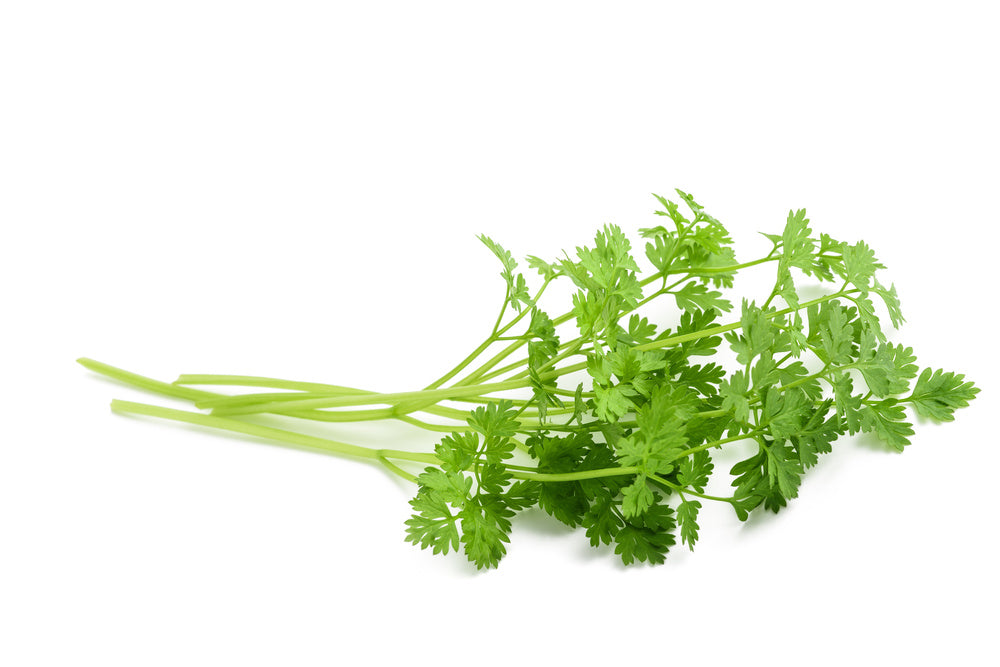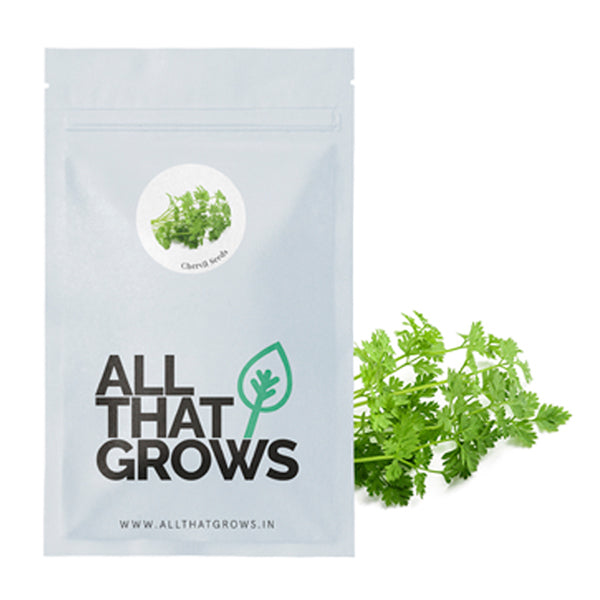



- SOWING
TIMEMarch to September
- Sowing
DistancePlant to Plant - 10-12 inches, Line to Line - 12-15 inches
- Fruit
WeightN/A
- Fruit
ShapeN/A
- Days to
maturity55 to 65 days
- Details
- How to sow
- Reviews
Chervil, pronounced Sher-vil, is a highly aromatic and tender annual herb that has an uncanny resemblance to flat-leaf parsley. Native to modern-day Georgia, Azerbaijan, Armenia and Russia region of Southeastern Europe, Chervil was spread throughout Europe by the Romans. Chervil is a staple in the French Cuisine and is counted as one of the “fines herbes” along with Parsley, Chives and Tarragon. Chervil has a delicate taste similar to that of parsley and star anise. Botanically known as Anthriscus cerefolium, Chervil is a member of the Umbellifers family. The aromatic notes of Chervil are rather short-lived, hence, it is best to harvest the herb only prior to consumption. The small feathery leaves of Chervil can be grown and harvested all year-round, though spring is the peak season for propagation. Chervil is a good source of Iron, Vitamin C, Calcium, Manganese, and antioxidant flavonoids lutein, zeaxanthin. Chervil can be cooked into recipes or served as a garnish on top of recipes that call for some fresh pairings. Chervil may lose its flavour quickly after harvest and is not ideal for drying.
Planting instructions
Much like other herbs, Chervil grows well in a rich loamy and moist soil. Direct sun can cause the plant to bolt. Hence, it is best to grow Chervil in partial shade. Sow the seeds ½ to ¼ inch deep in well-draining soil. The roots of the plant are rather delicate, therefore, it’s best to directly sow the seeds where it is to be grown in the garden. Chervil is also a great herb for growing in containers.
Growing Requirements
pests
Common garden pests like aphids, snails, can attack the leaves. The best remedy for all these is regular check-up and manual removal of affected parts. In addition, direct sun can cause Chervil plants to bolt and go to flowering and seeding. Keeping the plant away from direct sunlight and maintaining soil moisture is key to avoid the issue of bolting.
soil
Rich loamy soil with pH ranging between 5.5 to 7.0. A point to remember is to keep the soil constantly moist. Work up fresh compost to encourage ideal growth.
spot
Chervil must be planted in partial sunlight since full sun during the summers can cause the plant to bolt.
temperature
Ideal germination temperature for Chervil seeds should range between 15 to 20℃
watering
Regular watering is essential for growing Chervil properly. Hot and dry conditions can induce premature bolting or cause the plant to die.
how to harvest
Chervil leaves will become ready for harvest in about 8 to 9 weeks after sowing. Since Chervil can lose it’s pungency very quickly, it’s best to harvest the leaves just prior to consumption. In case you want to preserve the harvested herb, it’s better to freeze it, instead of drying the herb to retain some of its flavours.

Customer Reviews
The productiveness of any seed we sell is subject to your local climatic conditions*, the sowing method you adopt, and your commitment to the planting process. We give no warranty, expressed or implied, and are in no way responsible for the produce.
Please note that all our seasonal recommendations/ sowing information is as per the local climatic conditions. *For more information on the optimum conditions required for growing seeds in your region, please contact us at, hello@allthatgrows.in or Whatsapp us at, +91 8544865077
Questions & Answers
Have a Question?
Be the first to ask a question about this.




Chervil Seeds
Seed Type : Non-Hybrid, Open Pollinated and Non-GMO
SOWING TIME : March to September
PLANT CHARACTER : Delicate plant grows up to 15 to 20 inches
LEAF CHARACTER : Frilly Pinnated Leaves
HARVEST : 55 to 65 days after sowing
Grow this with
Chervil, pronounced Sher-vil, is a highly aromatic and tender annual herb that has an uncanny resemblance to flat-leaf parsley. Native to modern-day Georgia, Azerbaijan, Armenia and Russia region of Southeastern Europe, Chervil was spread throughout Europe by the Romans. Chervil is a staple in the French Cuisine and is counted as one of the “fines herbes” along with Parsley, Chives and Tarragon. Chervil has a delicate taste similar to that of parsley and star anise. Botanically known as Anthriscus cerefolium, Chervil is a member of the Umbellifers family. The aromatic notes of Chervil are rather short-lived, hence, it is best to harvest the herb only prior to consumption. The small feathery leaves of Chervil can be grown and harvested all year-round, though spring is the peak season for propagation. Chervil is a good source of Iron, Vitamin C, Calcium, Manganese, and antioxidant flavonoids lutein, zeaxanthin. Chervil can be cooked into recipes or served as a garnish on top of recipes that call for some fresh pairings. Chervil may lose its flavour quickly after harvest and is not ideal for drying.
Seed Type : Non-Hybrid, Open Pollinated and Non-GMO
SOWING TIME : March to September
PLANT CHARACTER : Delicate plant grows up to 15 to 20 inches
LEAF CHARACTER : Frilly Pinnated Leaves
HARVEST : 55 to 65 days after sowing
- SOWING
TIMEMarch to September
- Sowing
DistancePlant to Plant - 10-12 inches, Line to Line - 12-15 inches
- Fruit
WeightN/A
- Fruit
ShapeN/A
- Days to
maturity55 to 65 days
Planting instructions
Much like other herbs, Chervil grows well in a rich loamy and moist soil. Direct sun can cause the plant to bolt. Hence, it is best to grow Chervil in partial shade. Sow the seeds ½ to ¼ inch deep in well-draining soil. The roots of the plant are rather delicate, therefore, it’s best to directly sow the seeds where it is to be grown in the garden. Chervil is also a great herb for growing in containers.
Growing Requirements
pests
Common garden pests like aphids, snails, can attack the leaves. The best remedy for all these is regular check-up and manual removal of affected parts. In addition, direct sun can cause Chervil plants to bolt and go to flowering and seeding. Keeping the plant away from direct sunlight and maintaining soil moisture is key to avoid the issue of bolting.
soil
Rich loamy soil with pH ranging between 5.5 to 7.0. A point to remember is to keep the soil constantly moist. Work up fresh compost to encourage ideal growth.
spot
Chervil must be planted in partial sunlight since full sun during the summers can cause the plant to bolt.
temperature
Ideal germination temperature for Chervil seeds should range between 15 to 20℃
watering
Regular watering is essential for growing Chervil properly. Hot and dry conditions can induce premature bolting or cause the plant to die.
how to harvest
Chervil leaves will become ready for harvest in about 8 to 9 weeks after sowing. Since Chervil can lose it’s pungency very quickly, it’s best to harvest the leaves just prior to consumption. In case you want to preserve the harvested herb, it’s better to freeze it, instead of drying the herb to retain some of its flavours.



 Sign In
Sign In








